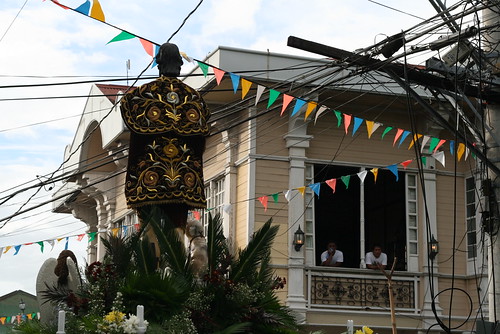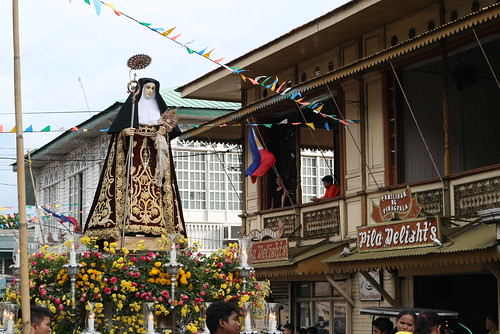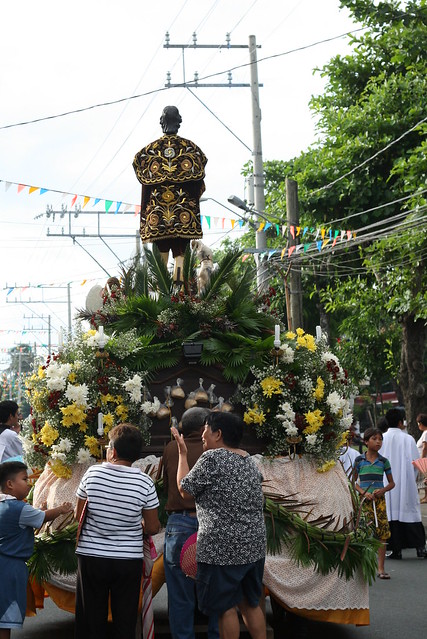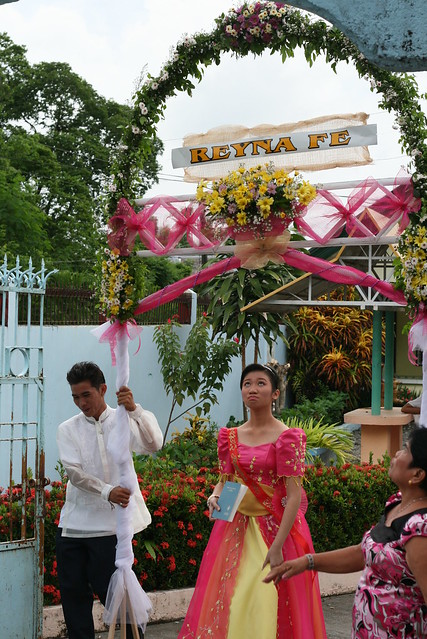"The weight of this sad time we must obey. Speak what we feel, not what we ought to say..."
~Shakespeare
It is with a heavy heart that I resume my posts in this blog. On Wednesday, the 26th of October, I woke up to a text message from a dear friend, Monette Alfon [writer, director, a student and friend of Sir Badong, who had also been my teacher] that our mentor
Salvador Bernal, National Artist for Theater and Design had passed away. My immediate reaction was of disbelief and sheer panic. Grief would not manifest itself until moments later...
I hurriedly sent a message to former teachers, PATDAT members, and schoolmates who were also members of Tanghalang Ateneo. Tita Monette's message was for real, but apart of me wanted to confirm it
-as if tangible time and space is mutable enough for it not to be real. To give thee an idea of how manic that message was, I quote:
"I just got a message from Tita Monette saying Sir Badong is dead. Is this for real? I stand between the precipice and I may lose it."
For the composure expected of me, that was probably not my best moment; and the dumbest text message question to ever come out of my shaking hands. Philosophy says much about truth and how much we are presented with it, yet we refuse to accept. And moments later, my dear friend, Sandro Lopa gives me a call. That was when i bawled, and no modicum of composure was left in me.
"Oh my god, he's dead..." and many other things like,
"I never even got to see him last year at Saint Luke's" or
"I was supposed to invite him to see our movie." and perhaps the most painful of all,
"He did not even get to see the proofing copy of my book." And for lack of any way of putting it,
my tears never fell so for anyone else in my life, the way it fell for Sir Badong.
And after that, Ara Fernando, Dr. Ricky Abad, and Eric Pineda let the bitter reality come to form.
There was no way of molding it to another reality sans tears, sans sighs, sans this emptiness.
I was a deluded showtune singing college sophomore at the Ateneo de Manila when I met Sir Badong. I was the cliche theater major who was raised listening to 45RPMs of Jesus Christ Superstar, Camelot, and West Side Story, totally skipping over classical Greek Drama and Shakespeare to lip-sync to the Complete Symphonic Recording of Les Miz. I had entered the Theater Arts Program of the Ateneo entirely oblivious of what we define as classical theater training.
But even though I took Theater Arts as a major, I really had no idea what kind of theater practitioner I was going to be -part idealistic, part too young to care. It was not until I started helping out with the gold leaf transfer sheets on the jewelry pieces of Twelfth Night that I began to consider working in Production Design. I began sitting-in at Sir Badong's Production Design Classes even though I was not to take the course for about two more semesters. And as Aesthetics, Interdisciplinary Approaches to the Arts, Production Design, and production work for Tanghalang Ateneo marked the time, Sir Badong's influence changed how I viewed the world of the Theater.
It was the collaborative creative partnership of Dr. Ricardo Abad and Professor Salvador Bernal that advocated the identity of the Filipino and the Asian in every endeavor upon the Ateneo stage. Shakespeare's Illyria became a Tropical Pan-Asiatic Paradise with a gilded Menangkabau house that transformed as it turned, Segismundo's tower became a labyrinth of mirrors clutched by a giant hand in La Vida es Sueno, Padua became Paracale in 1913 Philippines for Taming of the Shrew, and many other worlds in their infinite variety made me believe in the possibility of the impossible in the theater.
Sir Badong would say in a tone of voice that was his and his alone,
"Niki, your costumes look like a variety show's -Change it!" I had not picked up a pencil to draw after I turned thirteen. It was during Sir Badong's Production Design Class that I started to draw again. It was when I picked up a watercolor brush to draw costume plates, learned costume plot palettes, proportion, operatic scale, building maquettes or bocetos, learned drape and fold. And above all this, Sir Badong taught me how an entire stage, just by looking at a single detail or curlicue, can tell a story. How its scenic transformations can be as magical as their picturesque end. How in a falling scrim, men are made or broken. He taught me to look at the hidden meanings in art. The conditions to which a costume developed and why it was worn a certain way. He taught me how to defend my work and to stand by it.
My greatest flaw as a Production Designer, they say, is
"over-thinking designs". But if you knew where we, his students, were coming from, you would see why. [Pausing here, sigh]
Nothing will come from nothing, he once reiterated. A Production Designer can't just say,
"Feel ko lang eh" [I just feel like it] every time he comes up with a design concept. A cohesive Production Design comes to form from respect for the material [the play], proper research, filtering research, taking collaborative input, executing with practicality in mind, and an uncompromising resolve to get it done and get it done well.
Under the circumstances of a Third World Theater scenario, Sir Badong taught us to use rafia lined with soft canvas in replicating pineapple fibre weave on stage to create a blouse for the Traje de Mestiza; when gold stamping was impossible on velvet, he had Ara Fernando experiment with rubberized textile paint silkscreened over the rich fabric achieving the effect of oriental embroidery; and the legends of Bic ballpen chandelier crystals, woven mat armor, vats of tie-dyed satin and cotton, an entire car of beaded evening gowns that went unpaid by some fallen superstar, seem fresh as they were retold and regaled during his wake.

Sir Badong was direct, his criticisms were filled with his brand of wit, and his approval or praise was precious -if ever it came. I remember as Gino Gonzales, Eric Pineda, Tita Monette, Toto Gonzalez and I were discussing how tasteful the floral arrangements were and how he would approve, there was this quip that stopped the conversation that went, "When did he ever approve of anything we came up with?" followed by collective laughter and a sigh. That for me, says how much he expected of those he taught.
When there were but a few guests left during the first night of his wake, I finally got to approach Sir Badong where he lay. I stood there for God knows how long, my right hand clutching my neck, and i stared at his visage -now without the authoritative or critical gaze he used to give me. Marked I what Rafael Del Casal uttered earlier that evening, looking at Sir Badong, there was this serenity about him, as if his lifeless coil communicated how he has finally been released of this world.
The rest of us still have to live without him now... Three generations of Sir Badong's legacy represented there, knew what loss was there that night.

Come Saturday, the 29th of October, was the Cultural Center of the Philippines' [CCP] Tribute to the National Artist that was Sir Badong. I got there quite early.... very, very,early... 7:30 in the morning to be exact. As I waited for the funerary coach to make its way to the ramp of the CCP, I was happy to be in good company. My old college blockmates Ara Fernando -whom Sir Badong calls his daughter- and Jason Vitorillo, fellow Tanghalang Ateneo alumni. When we finally decided to sit after being told that only the CCP and NCCA Officials were supposed to welcome him at the door [which was an atrocious thought, mind you, but we are civilized Jesuit-bred individuals after all], I sat beside Fides Cuyugan-Asencio and talked shop a bit. In the middle of it, during a pause, I gave out quite a sigh. To which the elegant lady Tita Fides responded, "Don't sigh. You're too young to sigh."
The CCP Tribute was as expected of it. National Artist Bienvenido Lumbera, and some others paid tribute in words, dance, and music [Although those coming from the CCP's and the NCCA's representatives felt and sounded derivative, and Dr. Ricky Abad was not invited among them, it smelt of politics]. Sir Badong's poetry, good taste, wit, undeniable genius, teachings, and unparalleled achievements were celebrated. Yet Veteran Theater Director Nonon Padilla hit the proverbial nail on the wall by saying how the CCP he and Sir Badong left some years ago has turned into the hive of bureaucrats that it are subject to loyalty checks after every regime. But that is one truth we all have to contend with in "a culture that glorifies mediocrity" as Gino Gonzales put it.
Of all of them, Gino Gonzales' words turned my sighs to tears. He represented all those that came under Sir Badong's tutelage, of how we took that critical turn under Sir Badong and were changed from hence, and of course how we cannot survive on skyflakes [the irony of the sheer number of Sir Badong's Ang Kiukok collections was counterpoint to that, I thought].
And as a chorus of 200 voices sang Candomble, I could see Nick Tiongson in his seat, inconsolable and in tears; then the pallbearers from the military took his coffin from the stage, through the auditorium, and through the doors of the CCP Main Theater. As they did so, "Bravo Badong!" and applause rang through this nation's crumbling sacred temple to the arts.
It pains me to write this, a finality to solidify that reality.... But as always, all that is left is just to live.
So, Bravo, Sir Badong!
You were a bright light upon the stage, untimely extinguished, yet radiantly enduring...
A student is unable to pay tribute to his teacher if he has nothing to show when he returns to his chambers, but you left too soon, and I was unable to offer and place it upon your hands. Wherever you are, Sir Badong, in the infinite number of possibilities and hope, my gift will find you in the days to come.
thus I end this with tears and quoting your wit, "Sige kayo, according to Plato, you will all go to hell."
Your Student,
Niki de los Reyes-Torres
the barefoot baklesa
[all photographs courtesy of Ara Fernando]
































































